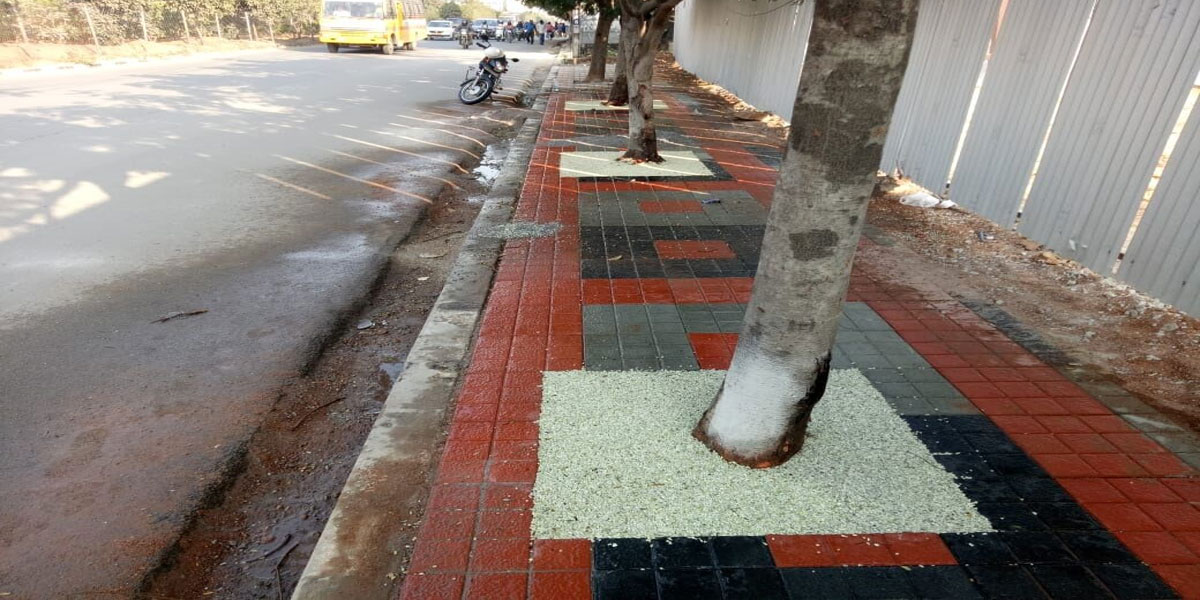Trees on footpaths get to breathe well

The Greater Hyderabad Municipal Corporation GHMC West Zone Commissioner, Hari Chandana Dasari came up with a new innovative method for tree plantations
Hyderabad: The Greater Hyderabad Municipal Corporation (GHMC) West Zone Commissioner, Hari Chandana Dasari came up with a new innovative method for tree plantations. For the first time in India, the Commissioner installed around 150 trees on a 6 km stretch of 100 feet road in Madhapur with a new method called Resin-Bound Permeable Paving. Resin-Bound Permeable Paving is a new scientifically proven method for tree planting on streets. A mixture of aggregate stones and resin is used to pave pedestrian walks, which are called as Resin Bound Tree Pits, providing the necessary solution for urban tree plantings. With this there are no open tree grates that causes litter and waste and eliminates pedestrian tripping hazards and growth of weeds.
Referring to the article written by Len Phillips and Gordon Mann on paving around street trees, Hari Chandana told The Hans India: “Municipal arborists around the country are looking at options for improving the aesthetics, reducing maintenance, and discouraging compaction of the soil surrounding downtown trees planted next to the concrete sidewalks.” She said, for many years, metal tree grates were the standard option, but they require routine maintenance, and were rather expensive to purchase. As enlarging them was not possible as the tree grew bigger, they had to be discarded thus safety of the grown-up tree was at risk. In recent years, some new pavement products have been used to replace these metal tree grates. These products have been installed around sidewalk trees in several downtown cities of Europe. The pavements vary from 100 percent soil mix, to stone aggregate, and to recycled rubber chips, all in varying proportions of mix. All of these options eliminate the metal tree grate and frame footing.
Describing the flexible pavement option, Hari Chandana said a flexible surface is created around the tree by spreading rubber chips or small paving stones that have been bonded together with a high-quality clear resin or urethane binding agent, on the soil surface. It results in a flexible, porous surfacing material, which is resistant to cracking. The products are mixed on-site and applied to coat the particles prior to laying the material on the ground. The material is easily cut to enlarge the hole around the trunk as the tree grows. The pavement material is usually not re-usable. Further, she said paving allows water to freely drain through the surface. This is non-skid, 50 percent rubber content and 50 percent stone aggregate surface along with a hard urethane binder ensuring good traction even when wet, lessening the chance of slip and fall accidents.
In addition, the rubber content allows the product to flex with trunk growth, or with any roots that come to the surface. This flexibility resists cracking and heaving commonly found with concrete sidewalks. The porous and flexible rubber content prevents soil compaction but allows air and surface water penetration, which encourages the tree roots to grow deeply. The paving products comes in several custom colors such as gray-black, tan-black, brown-black, cypress-black, red-black, brown-tan, green-brown and blue-gray. The surface is easily cut to enlarge the hole around the trunk as the tree grows. Porous paving, Resin Bonded Surfacing and Hoggin are the various products used in paving. Accordingly, GHMC is trying to install paving for all trees in the west zone.

















